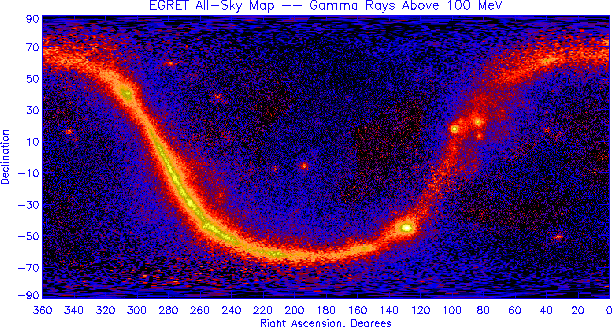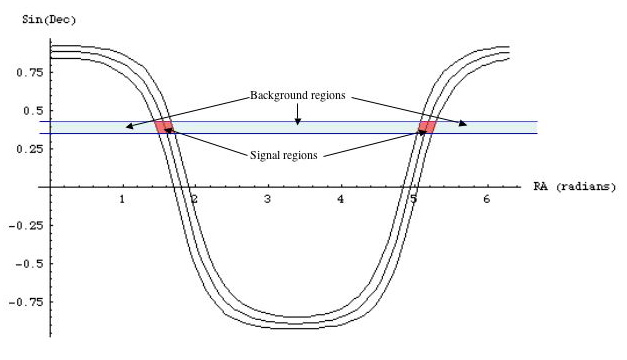
John Kelley, UW-Madison, August 2004

(EGRET View of the Galactic Plane, Celestial Coordinates)
Interactions of cosmic rays with the galactic interstellar medium are expected to produce a flux of neutrinos from the galactic disk. Because of the low density of the interstellar medium (approximately 1 particle / cm^3), the resulting hadrons generally decay before interacting, and thus the spectrum of the neutrinos produced should follow the cosmic ray spectrum — a power law of index -2.7 up to knee energies. See Learned & Mannheim, Annu. Rev. Nucl. Part.Sci.2000.50 for a nice overview.
The proposed analysis will search for an excess of neutrino events from the galactic plane, in the region below the horizon at the South Pole (the galactic longitude range 33º<l<213º). In particular, note that this does not cover the galactic center.
The analysis will initially use a blinded, pre-existing high-level sample of neutrino events below the horizon, without any additional cuts, such as a final event sample for a point-source analysis. Because of the large number of events and the lack of any specific energy cuts, the 2000-2003 combined point-source sample from Zeuthen is ideal for this purpose.
To count signal and background events, I propose a hybrid approach between a single point-source event-counting method and a stacked source analysis. To take advantage of the symmetric response of the detector at a given declination, the galactic plane region of the sky can be considered a collection of sources, each defined as one or two regions of the disk cutting across a given declination band.
For each of these slices of the plane, the on-source and off-source events can be counted, as shown in the diagram below:

Scaling of the background event count by the appropriate solid angle ratio is achieved by numerically determining the area of the on-source region. Currently, the galactic plane is defined (somewhat arbitrarily) as the region from -5º<b<+5º, where b is the galactic latitude. This will later be optimized as the signal hypothesis is refined, but the exact method of this optimization is still open.
Once signal and scaled background events are counted for each declination slice, the event counts are summed as in a stacked source analysis — i.e., on-source events and estimated backgrounds are simply added for each slice. The sensitivity as a function of zenith angle will be examined to determine if this approach is too simplistic and might wash out any signal.
A search for an excess from the galactic plane can simply use the procedure described above, but a full treatment, including a limit on the flux, requires simulation of a hypothesized signal.
The actual flux from the galactic plane is probably quite complicated. The EGRET maps of the high-energy gamma-ray flux from the plane (Hunter et al.) show a distibution that varies in width with galactic longitude, and is not even always centered around b=0º. Several models of the flux exist, as in Berezinsky et al., or Ingelman & Thunman (hep-ph/9604286). The former predicts an event rate in an AMANDA-sized detector of 5 events/year from the outer galaxy.
More complicated models can be explored, but as an initial step, I propose
simulating a line source from the galactic equator, with a flux constant in
galactic longitude. Currently this is achieved by adjusting the event times
and individual event weights from existing nusim atmospheric MC
output to simulate this line source, but eventually a different approach may
be used which directly simulates the desired flux without complicated reweighting.
A line source flux can be compared to existing models by integrating out the model's latitude dependence. An efficiency factor can also be added if the latitude range used in the data analysis does not actually span the full width of the model distribution.
This analysis is still in a preliminary stage, but event counting methods and the simulation of a line source have been tested using the 2000 Steele/Hauschildt point-source sample. The absolute normalization of the signal MC is still being worked out. As I proceed, I would like to switch to the Zeuthen 2000-2003 point-source sample as the primary data set for this analysis.